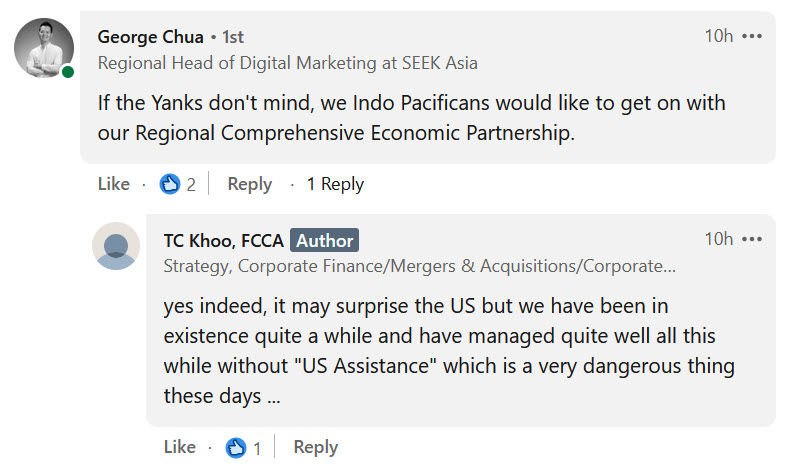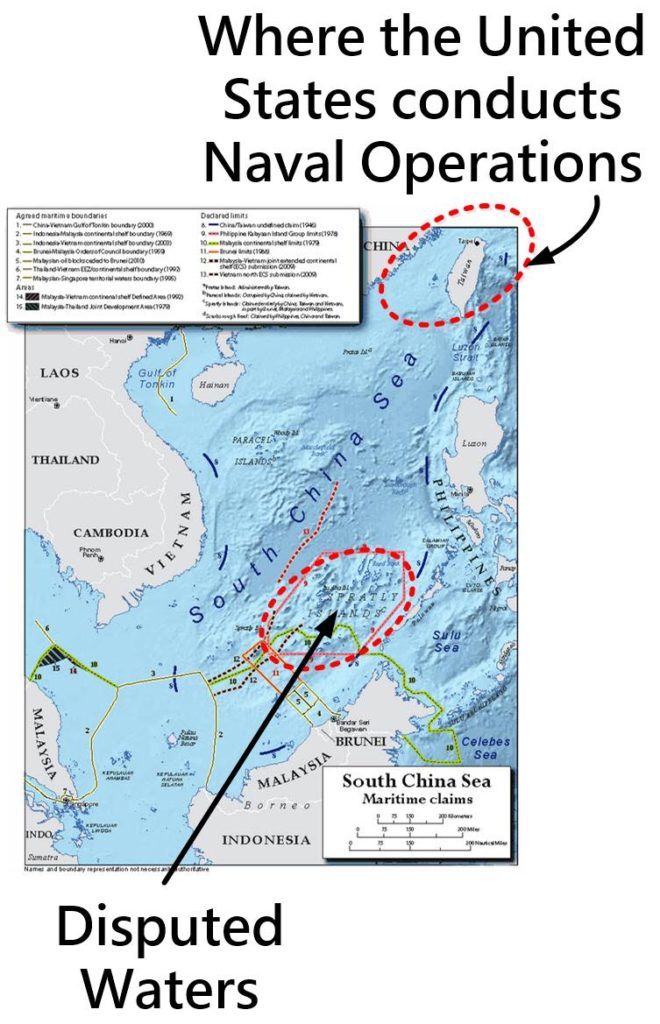Here, I continue on my “bender” on taking a look at other nations in our world. In each case, so far, I have shown the reality to be something different from what you would ever read about in the Western (especially the American) press. I have looked at China, Russia, Thailand, Cambodia, the middle East, and now, Vietnam.
Vietnam is a very interesting place full of great beauty, beautiful women, delicious food, and an easy going happy-go-lucky lifestyle.
Enter Donald Trump and his neocon war-mongers
Vietnam continued their easy and laid back lifestyle since the tumultuous 1960’s when America decided to churn up and rape the countryside for freedom™ and democracy™. And it continued that way through the decades, up until Donald Trump took office and started his “War on China”.
He demanded that American companies leave China or face all sorts of consequences. In American “language” this means that “border-line legal” actions might (and probably would) be directed at the company. Such as suspicious hard-line tax audits, and review of OSHA and EPA policies and factory operation shut-downs during the “investigations” as well as mysterious fires in the warehouses, random union uprisings and personal tax audits and random arrests of key corporate executives.
Many, but not all, American companies started to relocate a number of their operations out of China. The vast bulk did not return to America, however. Instead, they went to Mexico and Vietnam.
About Factories
When America switched from manufacturing inside of America to outsourcing to China, they did NOT teach the Chinese how to make factories or build products. Instead, they went to existing factories, handed over the blueprints, and quality specifications, moved their tooling and equipment, and said “make this for us”. And that is pretty much (as harsh as it sounds) what actually happened.
Now, in the thirty to forty years that America has been devoid of solid manufacturing skill, the American companies that manufactured inside of China were in a bind. Just how do you move your factory, when you don’t own it?
Do you start from scratch? Hire new engineers? Try to reverse engineer your systems to fit a Mexican or Vietnamese work force? What do you do?
Well, I can’t say that this is what happened to all of the factories, but I can tell you that a sizable number took this action…
…the Chinese factories that supplied the American companies, set up divisions inside of Vietnam.
Thus, the Donald Trump trade war, as far as bringing manufacturing capability back to the United States failed. Instead, all that happened is the existing Chinese factories continued to supply the American companies. The only difference is that they did so out of Vietnam.
Vietnam Changed.
Of course, all of this movement of Chinese factories into Vietnam, and with it, the Chinese support structures, have made great changes to Vietnam. While it is still a sluggish and rather backward nation, it is growing and expanding. And this has created a rather unique mix of older traditional Vietnam, with modern Chinese industry and support structures. Very few American influences are present. As America is rather a nation of bankers, accountants, lawyers, and diversity experts. Very few have an kind of impact on Vietnamese society.
Here we are going to look at some videos out of Vietnam taken these last two months. It’s a quite interesting mix of color and tradition.
The Videos
Let’s go through these videos.
I suggest you watch them in order to get the full diverse effect. And I hope hope that you enjoy them and get “something out of them”. This group has around 85 (give or take) videos. So to prevent you from getting carpal tunnel syndrome (yikes!) clicking on each individual video, I have clustered the videos into small zip files that you click on, download and then browse through at your leisure.
Group A
- Cooking some kind of purple Vietnamese food.
- Foreigner in Vietnam trying to pick up a local butterfly girl.
- Young love having some fun.
- Lunch in a Chinese factory located in Vietnam.
- Dressing up to go out on a date.
- You ride scooters to get anywhere.
- Making supper.
- Loved ones going off to do their mandatory military service.
- Some girls getting down at a local gathering.
- Another foreigner trying to pick up some butterfly girls.
- Night life in one of the bigger cities.
- Two girls on the way to work (my guess is a massage or restaurant).
- Bar Life.
- Home made turbo-generators for local village power needs.

You can download this entire archive HERE.
Group B
- Single 20-something girl in her one-room apartment.
- Hair stylist.
- Wedding party.
- Bride’s Maids showing their disdain for the bride for leaving them behind.
- Pretty Vietnam girl in a tea house.
- Pretty Vietnam farm girl in the field.
- Some 20-something’s “hanging out”.
- Pretty factory girl on the factory campus.
- Drunk factory girl in her shared dorm room.
- Classmates cheering up a sad girl.
- Before a wedding.
- Prep-cook.
- Lunch with beer and pigeon eggs.
- Vietnam government taking guidance from China and fighting COVID.

You can download this entire archive HERE.
Group C
- What small-town Vietnam is actually like.
- A typical highway between towns.
- Pretty girl doing a Tictok.
- Wedding tradition.
- Wedding reception activity.
- Girls of the night looking for customers.
- Picnic Vietnamese style.
- Female Vietnamese kick-boxer.
- Haircut and a shave.
- Happy birthday.
- Handing out money to those wearing masks.
- Chilled girl stopping by the side to put on a warmer top.
- One of the many wedding rituals.
- Butterfly Girl on the prowl in the night-life section.

You can download this entire archive HERE.
Group D
- Foreigner interacting with some “ladies of the night”.
- Not quite sure what is going on.
- Laundry on the porch.
- Young love at the factory.
- A beautiful Vietnamese girl.
- Leaving his house as he has to go off to work now.
- Lining up for vaccinations.
- Household savings.
- Nothing is sexier than a woman cooking.
- Working the farm.
- Washing hair outside.
- Traditional outfit.
- [Video messes up on MS systems about 50% of the time.]
- Traditional family.

You can download this entire archive HERE.
Group E
- Butterfly girls (prostitutes) lined up for some customers.
- making waffles for breakfast.
- City night ride.
- China giving away free “dead virus” (traditional) vaccines in Vietnam.
- Pretty girl 1.
- Pretty girl 2.
- A factory lunch.
- A friend had a little too much to drink.
- Off to the honeymoon.
- Night life.
- A girl of the night.
- Making products for American consumers in a Chinese factory in Vietnam.
- Farting at loved ones.
- I am not too sure what is going on here.

You can download this entire archive HERE.
Group F
- Foreigner picking up a butterfly girl.
- Another butterfly girl scores BIG.
- Pretty girl in traditional attire.
- OMG! What a sexy video!!!!!
- Night time going out to be with friends.
- Confrontation or something…?
- It’s hot! HOT!
- Healthy dinner.
- China is assisting Vietnam in the construction of hospitals.
- KTV fun. I wish I was there.
- Later on at the KTV things are getting a little crazy.
- You have to wear pants over your miniskirt while riding a scooter.
- Wedding exchanges.
- Friends partying.
- A bit of fun at a Chinese factory inside of Vietnam making products for Americans.

You can download this entire archive HERE.
On a topical note…
As the Biden administration consolidates its foreign policy, it has predictably turned its attention towards Southeast Asia in a bid to “counter China”.
Just last week, Mid-August 2021, Defense Secretary Lloyd Austin visited Vietnam, the Philippines, and Singapore in a bid to increase military ties between Washington and the region.
Means… allow American military bases there, American war ships to sail there, and the placement of American offensive missile systems there.
Right on China’s “doorstep”.
Imagine that!
Now, Kamala Harris is also set to visit two of these countries (Vietnam and Singapore), where the reported main message will be ‘America is Back!’ – a sentiment which will no doubt go down a storm in Hanoi.
You know like swallowing bile that rise up in your throat.
The vice president’s aim with this trip is to “call out” China over its maritime claims in the South China Sea.They can’t do it personally face-to-face with China. They will no longer play “that game”. So like cowards, they are trying to undermine all the relationships of all the nations that border on China.
They come with suitcases (no cross that out) pallets, (no cross that out) Shipping containers full of freshly minted US dollars.
Freshly minted.
Hot off the (over worked) printing presses.
For, you know, the leadership to do what ever they want with the nice crisp “green backs”.
This comes amid America’s attempts to militarize the region.
They’ve been really busy, don’t you know.
The anti-China QUAD; those vassal states of the UK and Japan who will be compelled to “die on their swords” at the push of a button from the American Pentagon. To Australia who has only become a vassal state for reasons not so obvious. In my mind, a treasonous Morrison government with many, many skeletons in his closet is willing to sacrifice his people for Washington DC.
As well as continuously sailing aircraft carriers through the sensitive waters in a bid to project American power.
It comes as Chinese Foreign Minister Wang Yi attends the ASEAN-China ministerial meeting, where he has warned against “external interference” by “extraterritorial powers” in the region.
No prizes here for guessing who he was talking about…

The US says that it’s “back” to Southeast Asian countries.
It’s just bullshit.
The reality is this: apart from all the militaristic “sabre rattling” and pushing a non-stop hate China narrative while convincing everyone (with a pulse) to oppose China, the United States actually doesn’t have a strategy for the region.
But Beijing does.
In many ways, the legacy of recent US policies in this area of the world has been self-defeating.
The “political space” (the room to maneuver and work around is) that Biden has to turn it around is really quite limited.
In other words, it’s essentially still Trump’s ‘America First’ sentiment.
And that is quite telling as the biggest gaping hole in America’s strategy towards Southeast Asian countries is failing to offer them anything in return.
There are no, absolutely zero, economic incentives to oppose China. All they have to offer is personal riches for the rulers. As well as promises to offer them “green cards” and citizenship if the whole plan goes “tits up”.
China, need I remind you, which is right next door to these nations.
On this front, America has isolated itself.
In so many ways too.
Most notably by withdrawing from the mega trade deal which Obama fashioned as an anti-China initiative known as the Trans-Pacific Partnership (TPP).
Now rebranded CPTPP (Comprehensive and Progressive Agreement for Trans-Pacific Partnership) amongst local partners.
On the level of US domestic politics, this is toxic because the consensus is that free trade is bad, especially if it detracts from jobs at home.
Therefore, Biden faces protectionist pressure not to re-join it, thus it has not come back on the Biden agenda.
China, on the other hand, has comprehensively doubled down on its economic ties with the surrounding region and entrenched its presence. Most notably through joining the ASEAN-led Regional Comprehensive Economic Partnership, which it quickly ratified.
This creates an obvious problem for America.
China is increasingly integrating itself with the region on an economic level.
In which local parties (Vietnam, Cambodia, Laos, Philippines, Singapore, Thailand, etc.) welcome with open arms gleefully.
But, you know, the United States is not happy with in the least.
China has, in addition, begun to move away from the US dollar in its business with these countries. This includes a local currency trade agreement with Indonesia and the setting up of an RMB bank in the Philippines, amongst other things.
No longer is trade being conducted in the “almighty” US Dollar. It’s local currency to the e-yuan. And as time moves forward, more and more nations are following this lead.
The US doesn’t have an answer to any of this.
Recently, it was reported that Washington wanted to try and propose a ‘digital trade deal’ among the economies of the Asia-Pacific. This “digital trade deal” is intended to lock China out of trade with any nations that sign that agreement. This is by regulation.
A favorite technique, mind you, well established and mature to crush nations that do not “toe the line” with American Geo-political policy.
This is intended to be done by setting strict rules and regulations on the ‘digital economy’ of the region.
Diplomatic sources dismissed it as a complete non-starter.
Why?
Because it’s absolutely untenable for these countries to lock China out, and it’s not hard to see why.
Yesterday (Mid-August 2021) Huawei announced it would be investing $100 million into over 1,000 software start-ups throughout Southeast Asia. And that’s just one of the many initiatives in bringing manufacturing, development, growth and prosperity to all the nations that surround China.
With a high degree of integration and economic benefits, it is impossible for the US to now shape the region’s initiative while keeping China excluded.
There’s nothing left.
This leaves the military.
And this is where China is increasingly powerful, but the US remains competitive and relevant.
Many countries in the region accept the presence of the United States and its allies militarily, because it gives them strategic space to prevent them from being completely dominated by China.
For a small city state like Singapore, this inclination makes obvious sense, but this is not so much ‘siding’ with America as it is a geopolitical balancing act between both powers.
Walking the “tight rope”; the “fine line” of neutrality.
Here lies the problem: America wants countries to align with it against China in a binary way, but the nations themselves want neutrality.
And ASEAN (The association of South East Asian nations) as an institution officially seeks such.
Singapore’s prime minister stated several days ago that it seeks balance between both powers, and did not want to become torn between them.
Seeks balance.
Seeks neutrality.
Seeks a uni-polar world.
Some of these states of course are formally allied with America, such as the Philippines. Yet, you know, for all intents and purposes they utilize a strategy of ‘hedging’ between both sides.
And for certain, they do not seek confrontation with Beijing.
If Washington pushes too hard on anti-China initiatives, these countries become uncomfortable, and this may have the ‘opposite’ result.
Recognizing what the US is doing, China is now pre-empting it by making diplomatic breakthroughs and concessions on the ‘South China Sea code of conduct’ – a proposal that has been in gridlock for decades.
This aims to ease tensions, and brands the US a ‘troublemaker’.
Duh!

Again, Washington doesn’t have the ability to conduct close diplomacy with these countries as a neighbor, only as a ‘visitor’.
America is an outsider.
China is local.
China is right there.
All in all, geography works against America. China is the neighbor of Southeast Asia, not the US.
Beijing is the largest economy in the region and is irreversibly integrated in terms of trade, technology, and finance.
America is not.
Yet, the US foreign policy strategy seems to pursue the bizarre premise that they can somehow dominate this region…
… push back China…
…and match its growing power…
… despite the fact they physically cannot, simply because they are not based there.
This means that whilst these countries are not necessarily rejecting an American presence, they are never going to adopt any serious anti-China policies or the militarization of the region that Biden hopes for.
Would you start a fight with your much bigger next-door neighbor?
Biden has no economic incentives to offer either.
China is, in many ways, continuing to lead and shape the regional agenda through its own initiatives, and as its own military presence in this area also grows, it has plenty of options to counter US posturing.
And the United States is impotent in the region, no matter what the American media says to the contrary.
Conclusion
Most of the world is still being influenced by the American media in one form or the other. And on subjects that everyone seems to have adjusted to what ever narrative that the American government made, the belief is that what ever Washington DC says is the truth. Nope. It is not.
Vietnam is many things, but an American proxy nation, whether military, commercial or economic, is simply not true.
This article broaches the true and actual state of affairs, and I do hope that it was interesting and meaningful at the same time. I have tried to present a diverse collection of videos showing the great breadth and width of the colorful Vietnamese society, and I hope that I put it in a positive light.
I have many friends how go to Vietnam, as it’s not too far from where I live, and they pretty much confirm what I have listed here. I hope that you all can see that it has a bright future ahead, and some deep and wonderful culture and traditions. I sincerely hope that they hold on to them and not allow them to disappear.
And when the pandemic ends, perhaps a nice visit to Vietnam would be a wonderful trip, and I am sure that you would make some wonderful, maybe even lifelong friends. And isn’t that what we all want out of life?
Do you want more?
I have more posts in my Happiness Index here…
Life & Happiness.
Articles & Links
Master Index.
- You can start reading the articles by going HERE.
- You can visit the Index Page HERE to explore by article subject.
- You can also ask the author some questions. You can go HERE to find out how to go about this.
- You can find out more about the author HERE.
- If you have concerns or complaints, you can go HERE.
- If you want to make a donation, you can go HERE.


